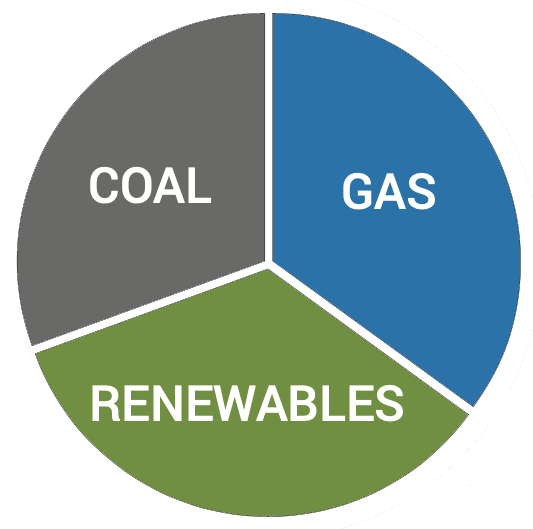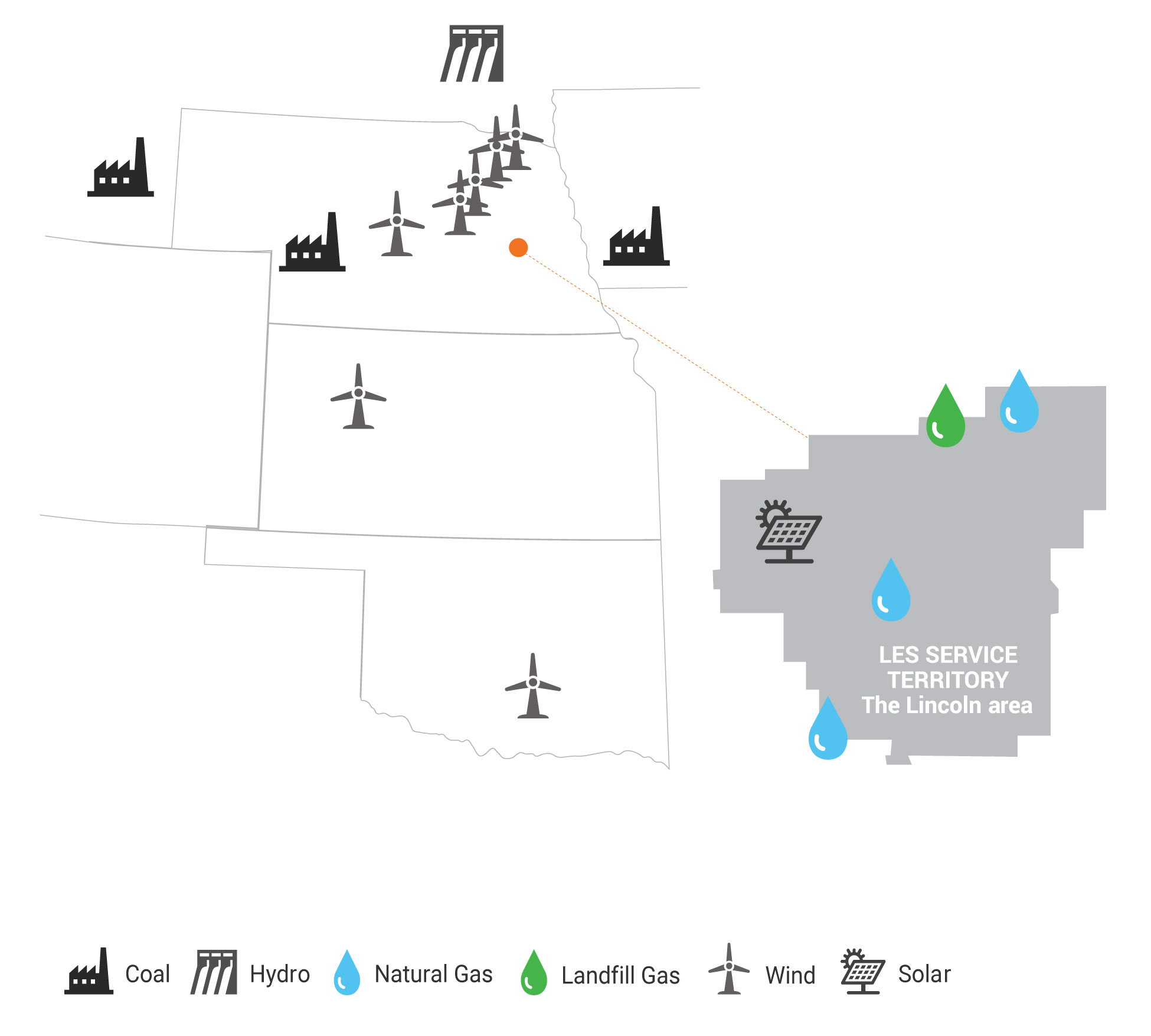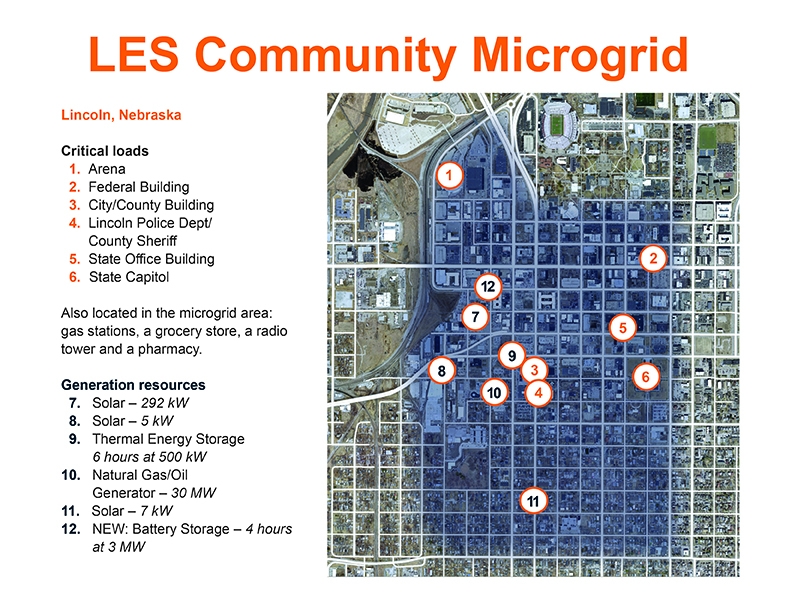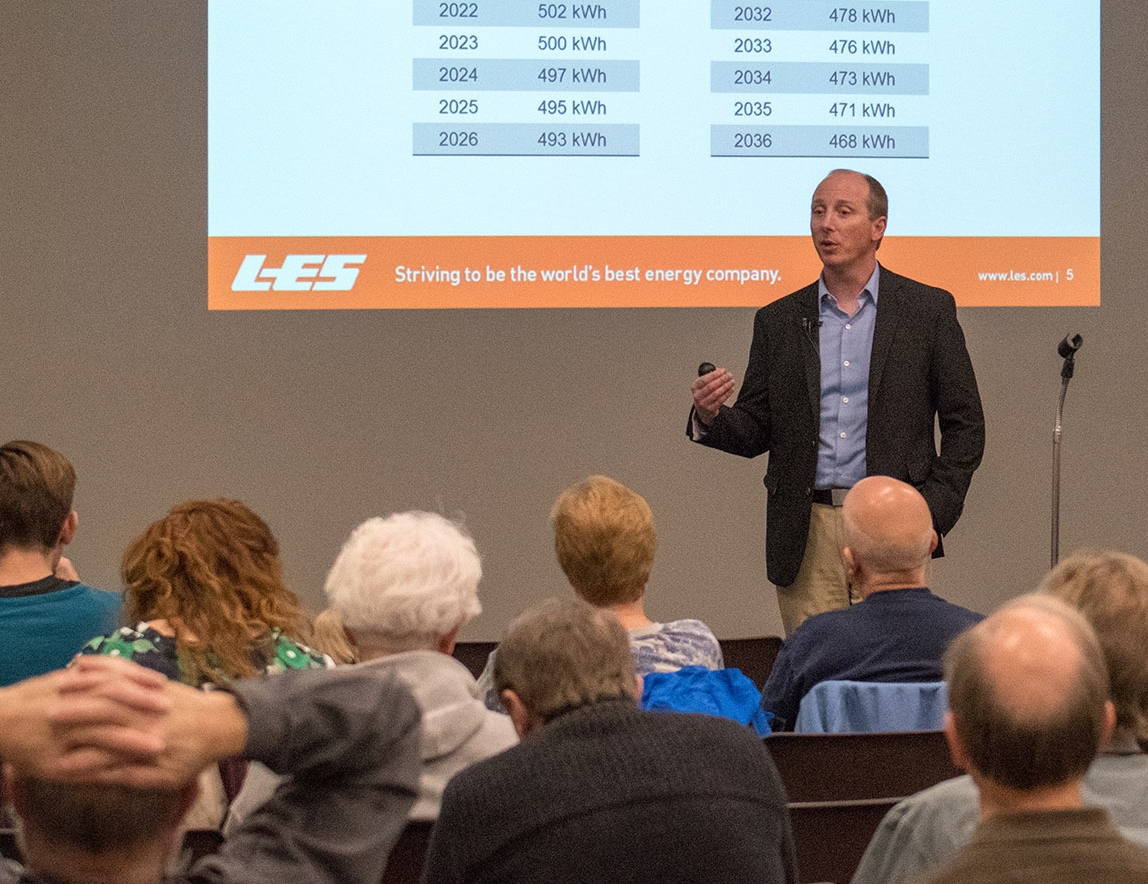LES has a variety of generation resources in its portfolio. Utilizing power from different sources in different places puts us on the map with one of the best portfolios in the industry. This mix of power resources provides LES flexibility, adaptability and stability in an ever-changing energy landscape, contributing to the reliable and affordable power our customer-owners in the community expect.
LES’ nameplate resource portfolio — the full capacity of our generation fleet — is diversified over several categories:
- Natural gas, 35%
- Renewables, 34%
- Wind
- Hydro
- Solar
- Landfill gas
- Coal, 31%
Click on the title below to learn more about each of them.
J Street // LES’ oil- or natural gas-fired power plant with one simple-cycle combustion turbine totaling 30 MW was installed in 1972.
Rokeby Generation Station // LES’ primary peaking power station with three oil- or natural gas-fired simple-cycle combustion turbines totals 254 MW including a 3-MW diesel gen-set. The combustion turbines were installed in 1975, 1996 and 2001.
Terry Bundy Generating Station // LES’ oil- or natural gas-fired, 164-MW plant uses waste heat from two aeroderivative combustion turbines to create steam, which is used to operate a steam turbine and generate additional power in a combined-cycle configuration. A third aeroderivative combustion turbine is operated in simple cycle. The plant also has a 2-MW “Black Start” unit on-site. The combustion turbines were placed in commercial operation in 2003 with the steam turbine following in 2004.
Bluff Road Landfill Gas to Energy* // LES completed construction of a 5-MW, landfill gas-generated facility in 2014. The methane fuel is supplied from the Bluff Road Landfill.
Western Area Power Administration // LES purchases 54 MW of firm power, 72 MW of summer firm peaking and 21 MW of winter firm peaking power from this hydropower resource. LES’ contract currently runs through 2050.
Wind*
- Elkhorn Ridge Wind Farm // LES began receiving energy from a share of the Elkhorn Ridge Wind Farm in March 2009, located 5 miles north of Bloomfield in northeast Nebraska. LES entered into a power purchase agreement for 6 MW of the total 80-MW wind project, which consists of 27 wind turbines.
- Laredo Ridge Wind Farm // LES began receiving energy from a share of the Laredo Ridge Wind Farm in February 2011, located northeast of Petersburg, Nebraska, in Boone County. LES entered into a power purchase agreement for 10 MW of the total 80-MW wind project, which consists of 54 wind turbines.
- Crofton Bluffs Wind Farm // In November 2012, LES began receiving energy from a share of the Crofton Bluffs Wind Farm located southwest of Crofton in northeast Nebraska. LES entered into a power purchase agreement for 3 MW of the total 42-MW wind project, which consists of 22 wind turbines.
- Broken Bow Wind Farm // LES began receiving energy from a share of the Broken Bow Wind Farm in December 2012. LES entered into a power purchase agreement for 10 MW of the total 80-MW wind project, which consists of 50 wind turbines. The project is located just east of the community of Broken Bow in central Nebraska.
- Arbuckle Mountain Wind Farm // LES began receiving energy from the Arbuckle Mountain Wind Farm in November 2015. LES entered into a power purchase agreement for the full 100-MW project, which consists of 50 wind turbines. The project is located in south-central Oklahoma, about 80 miles south of Oklahoma City.
- Buckeye Wind Energy Center // LES began receiving energy from the Buckeye Wind Energy Center in October 2015. LES entered into a power purchase agreement for the full 100-MW project, which consists of 56 wind turbines. The project is located in north-central Kansas, about 5 miles north of Hays, Kansas.
- Prairie Breeze II Wind Energy Center // LES began receiving energy from the Prairie Breeze II Wind Energy Center in December 2015. LES entered into a power purchase agreement for the full 73-MW project, which consists of 41 wind turbines. The project is located in northeast Nebraska, about 5 miles east of Elgin, Nebraska.
Community solar project* // Generating 5 megawattsDC of solar energy, the LES community solar facility was the first utility-scale solar installation in Nebraska and is still one of the largest in the region. This project is located at Northwest 75th & West Holdrege streets in Lincoln and went online June 2016.
Through our virtual solar program, customers can pay for "virtual" solar panels — an investment representing a portion of the LES community solar facility's output. Participants will receive a credit on their electric bill each month related to the number of virtual panels invested in and the actual energy production of the solar facility.
LEARN MORE ABOUT/BUY A VIRTUAL PANEL
*LES is selling the Renewable Energy Certificates associated with these generating resources and the renewable attributes are transferred to the REC recipient.
Laramie River Station // LES owns 12.76 percent of this coal-fired power plant with approximately 10.5 percent, or 178 MW, available after ownership and participation sales. Construction was completed in 1982 on this three-unit plant.
Gerald Gentleman Station // Owned by Nebraska Public Power District, LES participates under a life-of-plant contract by purchasing 8 percent of the output, or 109 MW. The final phase of this coal-fired plant was completed in 1982.
Walter Scott, Jr. Energy Center Unit 4 // LES owns 12.66 percent of Walter Scott, Jr. Energy Center Unit 4 near Council Bluffs, Iowa. This coal-fired plant was completed in 2007 and provides LES 102 MW. To further diversify generation, in January 2008 LES executed an agreement with MidAmerican to exchange energy derived from 50 MW of Unit 4 with 50 MW of Unit 3.





